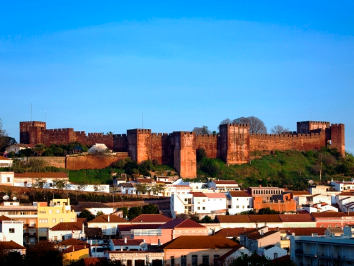The Silves, over the river Arade, is the largest castle in the entire Algarve region.
Even before the beginning of the construction of the Castle of Silves, an old fortification already existed in this place, probably built by the Romans or the Visigoths.
From the 8th century, after the invasion of the Iberian Peninsula by the Muslims, the new lords of as-Shilb (Silves) began the construction of this fort.
Due to its privileged geographical position, the population of as-Shilb grew rapidly.
In the following centuries the village of as-Shilb knew its heyday, becoming the scene of several disputes between Muslim princes, eventually being conquered by King Al-Um'tamid in the year 1052.
It was at that time that the surrounding wall of about twelve hectares was built. It is a wall with three doors and reinforced by square towers.
Internally, there were two main streets that constituted the two axes that defined the village. Very close to the Porta de Almedina, also called Porta Principal or Porta de Loulé, there was a large building, the Palácio das Varandas, which although it no longer exists, is mentioned in the poetry of King Al-Um'tamid.
Even before the beginning of the construction of the Castle of Silves, an old fortification already existed in this place, probably built by the Romans or the Visigoths.
From the 8th century, after the invasion of the Iberian Peninsula by the Muslims, the new lords of as-Shilb (Silves) began the construction of this fort.
Due to its privileged geographical position, the population of as-Shilb grew rapidly.
In the following centuries the village of as-Shilb knew its heyday, becoming the scene of several disputes between Muslim princes, eventually being conquered by King Al-Um'tamid in the year 1052.
It was at that time that the surrounding wall of about twelve hectares was built. It is a wall with three doors and reinforced by square towers.
Internally, there were two main streets that constituted the two axes that defined the village. Very close to the Porta de Almedina, also called Porta Principal or Porta de Loulé, there was a large building, the Palácio das Varandas, which although it no longer exists, is mentioned in the poetry of King Al-Um'tamid.
According to what is recorded in the chronicle of Xelbe, at the end of the twelfth century, the village of as-Shilb was a dynamic urban, commercial and cultural center of the Islamic world. At the beginning of the 13th century, the last Muslim king, Ibn al-Mahfur, started the Almohad reform of its defenses, giving it the general lines with which, with the exception of some minor alterations, the Castle of Silves has survived to the present day.
At the time of the Christian Reconquest, around 1189, with the help of a fleet of English and German crusaders, the Portuguese armies surrounded Silves, with the aim of conquering it. The siege began in the second half of July and would last more than a month, and after violent attacks with a wide variety of war machines, such as wooden towers, catapults and others, on September 2, after the destruction of several towers and sections of the walls, the village ended up surrendering, being violently looted.
Later, in 1191, the Muslims, under the command of the caliph Abu Yusuf Ya'qub al-Mansur, counterattacked and conquered again all the territories south of the Tagus River, with the exception of the village of Évora. Thus, the Castle of Silves was once again in the hands of the Muslims, with whom it remained for little more than half a century.
In 1242, the knights of the Order of Santiago, commanded by their Master, D. Paio Peres Correia, attempted to reconquer Silves. However, it was only in 1253, under the reign of King Afonso III of Portugal, that the village of Silves and its castle returned to Portugal. In 1266, the sovereign granted the town of Silves its Charter, determining the recovery and strengthening of its defences.
In 1755, in the earthquake that occurred near Lisbon, the structure of the Silves castle and its walls were severely damaged.
Later, in 1191, the Muslims, under the command of the caliph Abu Yusuf Ya'qub al-Mansur, counterattacked and conquered again all the territories south of the Tagus River, with the exception of the village of Évora. Thus, the Castle of Silves was once again in the hands of the Muslims, with whom it remained for little more than half a century.
In 1242, the knights of the Order of Santiago, commanded by their Master, D. Paio Peres Correia, attempted to reconquer Silves. However, it was only in 1253, under the reign of King Afonso III of Portugal, that the village of Silves and its castle returned to Portugal. In 1266, the sovereign granted the town of Silves its Charter, determining the recovery and strengthening of its defences.
In 1755, in the earthquake that occurred near Lisbon, the structure of the Silves castle and its walls were severely damaged.
A must visit!
Photo credits: Silves Municipality



Comments
Send a comment